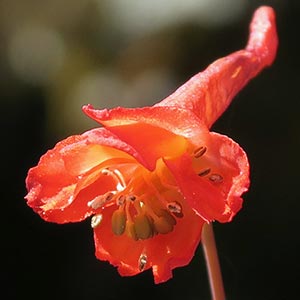Delphinium nudicaule
Delphinium barbeyi
canyon delphinium, canyon larkspur, orange larkspur, red larkspur, red or orange larkspur, scarlet larkspur
Barbey larkspur, Barbey's larkspur, subalpine larkspur, tall larkspur
(15-)20-50(-125) cm;
base reddish, glabrous.
50-150 cm;
base green, glabrous.
blade round to pentagonal, 2-6 × 3-10 cm; ultimate lobes 3-12, width 5-40 mm (basal), 2-20 mm (cauline).
blade round to reniform, 4-8 × 7-15 cm, glabrous; ultimate lobes 5-9, width 8-50 mm.
5-20(-69)-flowered;
pedicel (1.5-)2-6(-8) cm, glabrous to glandular-pubescent;
bracteoles 14-20(-30) mm from flowers, green to red, linear, 2-4(-9) mm, glabrous to puberulent.
10-50-flowered;
pedicel 0.5-6 cm, glandular-puberulent;
bracteoles 1-4(-8) mm from flowers, blue to green, awl-shaped, 5-14 mm, puberulent.
sepals scarlet to reddish orange, rarely dull yellow, glabrous, lateral sepals forward-pointing to form pseudotube, (6-)8-13(-16) × 3-6 mm, spurs straight, slightly ascending, (12-)18-27(-34) mm;
lower petal blades elevated, exposing stamens, 2-3 mm, clefts 0.5-1 mm;
hairs sparse, evenly dispersed, yellow.
sepals dark bluish purple, sparsely puberulent, lateral sepals forward pointing, 13-23 × 5-8 mm, spurs ascending ca. 45°, downcurved apically, 10-18 mm;
lower petal blades ± covering stamens, 4-7 mm, clefts 2-3 mm;
hairs centered, mostly near base of cleft, sparse elsewhere, white or yellow.
13-26 mm, 3.5-4.5 times longer than wide, glabrous.
17-22 mm, 2.5-3 times longer than wide, puberulent.
unwinged or sometimes slightly wing-margined;
seed coat cells with surfaces smooth.
wing-margined;
seed coat cells narrow but short, surfaces pustulate.
= 16.
= 16.
Delphinium nudicaule
Delphinium barbeyi
Delphinium nudicaule hybridizes with most other taxa of Delphinium that it encounters. Apparent hybrids involving D. nudicaule, and seen by the author (either afield or as specimens), include D. andersonii, D. antoninum, D. decorum, D. luteum, D. nuttallianum, D. patens, and D. trolliifolium. In addition, garden-grown plants have been hybridized with D. cardinale, D. elatum, D. menziesii, D. parishii, D. penardii, D. tatsienense Franchet, D. triste Fischer ex de Candolle, and D. uliginosum; D. nudicaule does not naturally occur with these species. Delphinium nudicaule is one of the earliest larkspurs to flower in any given locality. Douglas's type collection of D. nudicaule represents plants (synonyms D. sarcophyllum Hooker & Arnott and D. peltatum Hooker, an invalid name) grown under very moist conditions, probably quite near the ocean. The type specimen of D. armeniacum A. Heller represents plants grown under unusually dry conditions.
The Mendocino Indians consider Delphinium nudicaule a narcotic (D. E. Moerman 1986).
(Discussion copyrighted by Flora of North America; reprinted with permission.)
Delphinium barbeyi hybridizes extensively with D. glaucum in western Colorado and eastern Utah, where plants appearing to be hybrid [D. ×occidentale (S. Watson) S. Watson] are often far more common than plants of either putative parent. Several other names have been used for these plants, including D. elatum var. occidentale S. Watson, D. abietorum Tidestrom, and D. scopulorum subsp. occidentale (S. Watson) Abrams. Delphinium barbeyi is also known to hybridize with D. ramosum and D. sapellonis.
(Discussion copyrighted by Flora of North America; reprinted with permission.)


